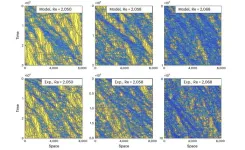Exposure to current levels of ground-level ozone (O3) in Europe is one of the main causes of premature mortality due to air pollution, especially in summer. A study led both by the Barcelona Institute for Global Health (ISGlobal), a centre supported by the "la Caixa" Foundation, in collaboration with the French National Institute of Health and Medical Research (Inserm), and the Barcelona Supercomputing Center - Centro Nacional de Supercomputación (BSC-CNS), has quantified for the first time the impact of imported (non-national) O3 on mortality. The results, published in Nature Medicine, have important implications for air quality and public health policies in the continent and within the European Union.
Ground-level ozone is a harmful air pollutant formed in the troposphere by the interaction of sunlight with several precursor gases, mainly nitrogen oxides (NOx) and volatile organic compounds (VOCs) from natural and anthropogenic sources. High O3 levels are associated with a range of adverse respiratory health effects, including aggravation of asthma, chronic obstructive pulmonary disease, lower lung function and infections, leading in the most severe cases to hospitalisation and death.
The research team quantified both national and imported O3 contributions to mortality across 35 European countries between 2015 and 2017, covering 813 regions and around 530 million people. The results show that imported O3 contributed to 88.3% of all deaths attributable to this pollutant. Most of this transboundary O3 came from outside the study domain (from hemispheric sources and transport), accounting for 56.7% of the total attributable mortality. O3 imported from the other 34 European countries also had a significant effect on mortality, accounting for 20.9%.
The concentration of O3 in a given location greatly depends on the tropospheric transport of the pollutant itself. “The health effects of O3, and of any air pollutant in general, are far from being a local issue. In this study, we found that 11.7% of deaths attributable to O3 were caused by national sources," says Hicham Achebak, a researcher at Inserm (France) and ISGlobal and holder of a Marie Sklodowska-Curie postdoctoral fellowship from the European Commission. "This fact underlines the need for coordinated actions at local, continental and global scales by all countries to reduce O3 concentrations and their impact on health," adds the first author of the study.
The analysis was based on data from the warm season (May to October), which is the season of highest O3 values. To track O3 concentrations, the study used the CALIOPE air quality system developed at BSC-CNS, which covers Europe and surrounding areas. This system tracks both O3 and its precursors (i.e. NOx and VOCs) that are formed or emitted in each region. To obtain data outside the study area, the researchers used a modelling approach that allowed them to track the dispersion and transport of air pollutants over long distances. The method also included emissions from both land and sea.
The average O3 concentration over all countries and the study period was 101.9 μg/m3, ranging from 76.7 μg/m3 in Finland to 130.1 μg/m3 in Malta. The estimated number of deaths attributable to O3 during the study period was 114,447 (estimated based on the whole range of O3 concentrations), resulting in an attributable mortality rate of 72 deaths per million population per year.
Most industrialised and populous countries contribute most to mortality
As expected, as warmer temperatures in the south favour the formation of O3, the concentrations of this pollutant decrease in the north of the continent. The highest mortality burdens were estimated in the most populated countries (Germany, Italy, France, the United Kingdom, Spain and Poland), whereas the highest mortality rates were found in the south-eastern countries (Bulgaria, Serbia, Croatia, Hungary, Greece and Romania).
The analysis also showed that within Europe the most industrialised countries were the major contributors to the mortality attributable to transported transboundary O3, especially France, with an estimated 4,003 deaths between 2015 and 2017, and Germany, with 3,260 deaths. O3 originating from France had a significant impact on neighbouring countries such as Luxembourg (32.3% of deaths attributable to O3), Switzerland (29.3%), Belgium (24.4%) or Spain (16.8%). O3 from Germany also significantly affected neighbouring countries such as Luxembourg (24.2% of deaths), the Czech Republic (23.3%) or the Netherlands (21.5%).
The results highlight the importance of westerly winds, with countries downwind towards the east having a higher number of deaths attributable to imported O3 from other European countries. South-western European countries were the least affected by the health effects of imported O3 from other European countries. In fact, Spain, France and Portugal were the countries with the largest fraction of attributable mortality caused by national O3 with respect to contributions from other European countries, accounting for 53.7%, 47.1% and 46.2% of deaths respectively, and the smallest imported/exported ratio of attributable deaths.
In some coastal regions and small Mediterranean countries, the contribution of shipping emissions was significant, such as Malta (24% of deaths) and Cyprus (14%).
Local, continental and global action to reduce pollution
The study underlines the need for a systematic quantification of national, EU and non-EU contributions to air pollution levels and associated health impacts as an essential step prior to the elaboration of regulation and mitigation plans, especially for air pollutants such as O3 that are easily transported across political borders.
"Thus far, mitigation efforts have focused primarily on national and regional scales, lacking a comprehensive, transboundary assessment of the associated health effects," says Joan Ballester Claramunt, ISGlobal researcher and co-senior author of the study. "Our study is a first step towards this in-depth analysis, which would help achieve WHO air quality standards to prevent premature deaths and other health impacts such as hospitalisations and chronic diseases," he adds.
Given the large non-national contributions to average O3 in each location, the study emphasizes that the results should not be interpreted by local air quality authorities as a justification for local inaction. "During the highest O3 episodes the local/national contributions can increase substantially, and local mitigation actions can contribute to considerably reduce daily exceedances of the regulated thresholds. Additionally, local mitigation strategies are key towards reducing the export of O3 to other regions and countries” argues Carlos Pérez García-Pando, ICREA and AXA Research Professor at the Earth Sciences Department of BSC-CNS and co-senior author of the study.
Climate warming will reinforce the conditions for tropospheric O3 formation in the future, as the photochemical mechanisms of O3 formation are favoured during heat waves and periods of high solar radiation. "Tackling climate change is key to improving air quality and, in turn, a key element to consider when designing and implementing long-term, long-lasting policies on a global scale. Also, future research should refine our results by analysing the contribution to mortality of the different economic sectors and natural sources, which are impacted by climate change." argues Oriol Jorba, Researcher and co-group leader of the Atmospheric Composition Group at the Earth Sciences Department of BSC-CNS.
Data from the 35 countries
O3 levels in 35 European countries, 2015-2017
O3 attributable deaths in 35 European countries, 2015-2017
Reference
Achebak, H., Garatachea, R., Pay, MT., Jorba, O., Guevara, M., Pérez García-Pando, C., Ballester, J. Geographic sources of ozone air pollution and mortality burden in Europe. Nature Medicine, 2024. Doi: 10.1038/s41591-024-02976-x
END





